Diffractometers in IMSERC
The center currently houses one electron, one open Eulerian cradle, and four kappa-geometry single-crystal diffractometers, and two powder diffractometers to meet a broad range of crystallographic needs. Most single crystal instruments are equipped with an Oxford Cryosystems nitrogen low-temperature unit, which can run experiments between 80-400K, and up to 500K on one instrument. Additionally, one powder diffractometer has the unique in-situ capabilities to perform measurements from 8 K up to 1,973 K. The IMSERC Crystallography labs are located in BG60/62/66 in Tech.
IMSERC also maintains three high resolution, polarized light microscopes available for student use in the Crystallography facility. Our Nikon SMZ1500 stereozoom and Leica S9i microscopes are equipped with a digital camera and video monitor for visualization of samples. Users can perform visual inspection of their samples with these instruments to assess crystal quality. High resolution photographs can be taken and used for publications or other presentations.
Rigaku Synergy-ED (Fully Available!)
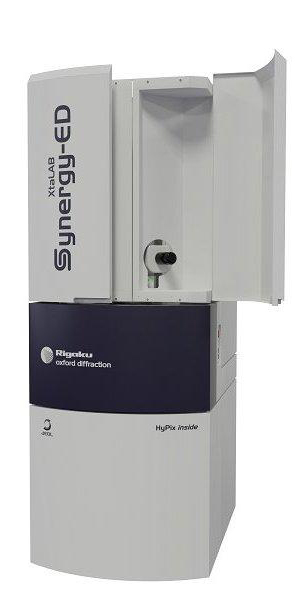
The first of its kind, dedicated 3D electron diffraction (3D ED)/Micro electron diffraction (microED) diffractometer (Synergy-ED) system for structure determination of nanometer sized crystals. microED can determine the molecular structure of crystals smaller than 1 μm, which are difficult to measure routinely even with synchrotron undulator beamlines. The XtaLAB Synergy-ED is a system any X-ray crystallographer will find intuitive to operate without having to become an expert in electron microscopy.
Capabilities
- Measure 3D diffraction data for structure elucidation on nanometer-sized single crystals
- Rapid collection using electronic-noise free Hybrid Photon Counting Detector for Electron Diffraction (HyPix-ED)
- Variable temperature option 105-300K (Gatan Elsa 698)
- Small volume (<1 ng) powder 2-dimensional microdiffraction
Stoe STADI-VARI
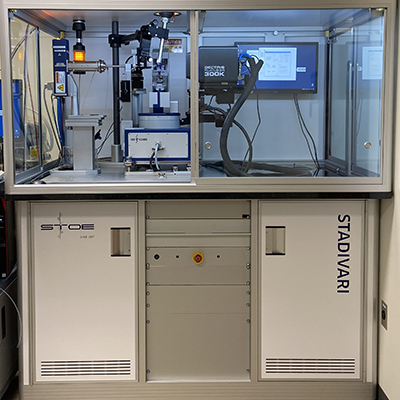
This state-of-the-art instrument runs our brightest AgKα microsource, perfect for small crystals (~10-100 μm) with heavy elements or good diffracting samples with light elements. This MRI-NSF funded diffractometer is optimized for non-standard measurements commonly found in synchrotron beamlines, such as high pressure and total scattering experiments for studying disordered, nanocrystalline, and amorphous materials. Additionally, 2D-micro-diffraction of powder samples (<1 μg) is available. This instrument is available for student use all days.
Capabilities
- Small weakly diffracting crystals with heavy elements using AgKα microfocus source with a beam size of ~100 μm
- High resolution Charge Density diffraction measurements
- Rapid collection using shutter-less electronic-noise free CdTe-based Hybrid Photon Counting (HPC) detector
- Low and high symmetry crystal structures using an open Eulerian cradle geometry goniometer
- Variable temperature option using either 80-400K (Cryostream Oxford Cryosystems) or 5-80K (Cryocool-LHe Cryo Industries) cryostats
- Small volume (<1 μg) powder 2-dimensional microdiffraction
Rigaku DW-Synergy
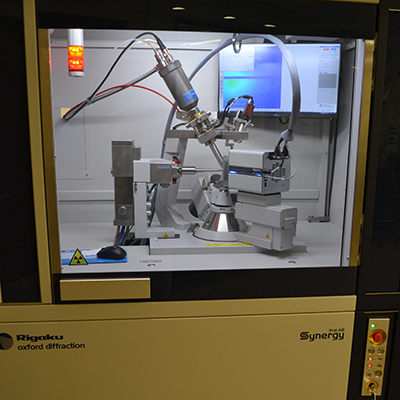
This state-of-the-art instrument equipped with a rotatining anode runs our brightest dual CuKα and MoKα microsource, with a small beam, perfect for small crystals (~10-100 μm) or weakly diffracting samples with light elements. Additionally, 2D-micro-diffraction of powder samples (<1 μg) is available for phase identification. The DW-Synergy is currently available for service work only. Please contact Crystallography staff if you would like to use this instrument for your project.
Capabilities
- Small weakly diffracting crystals with light elements using CuKα microfocus source with a Cu beam size of ~110 μm
- Small weakly diffracting crystals with light and/or heavy elements using MoKα microfocus source with a Mo beam size of ~80 μm
- Rapid collection using shutter-less electronic-noise free Hybrid Photon Counting (HPC) detector
- Low and high symmetry crystal structures using a 4-circle Kappa geometry goniometer
- Large (macromolecule) and small (small molecule) unit cell data collection with divergence adjustment from 9 mR to 1 mR
- Variable temperature option using either 80-400K (Cryostream Oxford Cryosystems) or 5-80K (Cryocool-LHe Cryo Industries) cryostats
- Small volume (1 μg) powder 2-dimensional microdiffraction
Rigaku Mo-Synergy
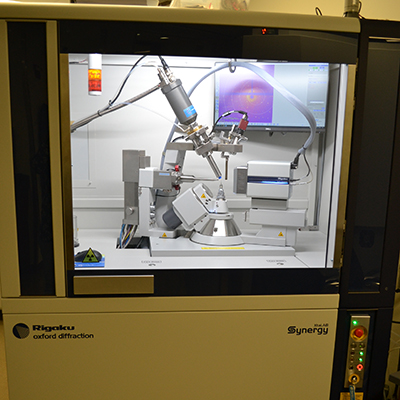
This state-of-the-art instrument runs our brightest MoKα microsource, perfect for small crystals (~10-100 μm) or weakly diffracting samples with light and/or heavy elements. Additionally, 2D-micro-diffraction of powder samples (< 1μg) is available for phase identification. The Mo-Synergy is available for student use all days.
Capabilities
- Small weakly diffracting crystals with light and/or heavy elements using MoKα microfocus source with a beam size of ~110 μm
- Rapid collection using shutter-less electronic-noise free Hybrid Photon Counting (HPC) detector
- Low and high symmetry crystal structures using a 4-circle Kappa geometry goniometer
- Variable temperature option using either 80-500K (Cryostream Oxford Cryosystems) or 5-80K (Cryocool-LHe Cryo Industries) cryostats
- Small volume (< 1μg) powder 2-dimensional microdiffraction
Rigaku Cu-Synergy

This state-of-the-art instrument runs our brightest CuKα microsource, with a small beam, perfect for small crystals (~10-100 μm) or weakly diffracting samples with light elements. Additionally, 2D-micro-diffraction of powder samples (<1 μg) is available for phase identification. The Cu-Synergy is available for student use all days.
Capabilities
- Small weakly diffracting crystals with light elements using CuKα microfocus source with a beam size of ~110 μm
- Rapid collection using shutter-less electronic-noise free Hybrid Photon Counting (HPC) detector
- Low and high symmetry crystal structures using a 4-circle Kappa geometry goniometer
- Large (macromolecule) and small (small molecule) unit cell data collection with divergence adjustment from 9 mR to 1 mR
- Variable temperature option using either 80-400K (Cryostream Oxford Cryosystems) or 5-80K (Cryocool-LHe Cryo Industries) cryostats
- Small volume (<1 μg) powder 2-dimensional microdiffraction
Stoe STADI-P

STOE’s STADI P runs on pure CuKα1 radiation. Powder samples can be measured in transmission geometry and high resolution powder data can be collected for qualitative structural analysis (e.g., Rietveld). Additionally, dry powder or polycrystalline samples in solution can be measured in spinning capillaries or spinning flat plate transmission holders. High throughput options for both transmission (up to 30 samples) and capillary (Debye-Scherrer, up to 10 samples) work are available. This instrument is available for student use all days.
Capabilities
- Pure monochromatic X-ray beam ideal for quantitative measurements using CuKα1 (without Kα2) radiation
- High throughput auto-sampler capable of loading up to 30 samples in flat plate transmission geometry or 10 samples in Debye-Scherrer (capillaries) geometry
- Fast acquisition using large 1D strip detector
- Flexible collection geometry for powders, liquids, or slurries using either transmission or Debye-Scherrer (capillary) geometry
Stoe STADI-MP
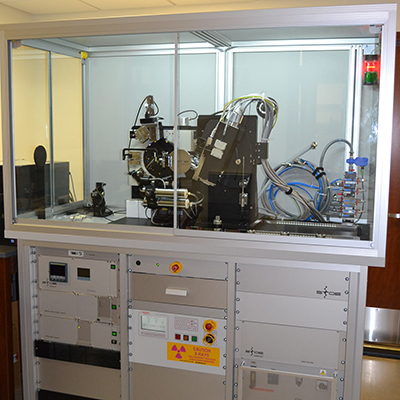
STOE’s STADI MP runs on pure Kα1 radiation (Cu-, Mo-, or Ag-sealed tube) and diffractometer is optimized for in-situ and variable temperature measurements. Powder samples can be measured in transmission or reflection geometry and high resolution powder data can be collected for qualitative structural analysis (e.g., Rietveld). STADI-MP has a unique furnace that allows in-situ measurements under any gases (e.g., corrosive atmosphere) as a function of temperature (up to 1600°C) and/or pressure (at least 20 atm). Additionally, Ag-radiation enables total scattering experiments for studying disordered, nanocrystalline, and amorphous materials. This instrument is available for student use all days.
Capabilities
- Pure monochromatic X-ray beam ideal for quantitative measurements using Kα1 (without Kα2) radiation of either CuKα1 or MoKα1 or AgKα1
- Flexible collection geometry for powders, ingots, pellets, liquids, or slurries using either transmission or reflection or Debye-Scherrer (capillary) geometry
- Fast acquisition using large 1D strip detector
- Variable high temperature (up to 1600°C) attachments for in-situ/operando measurements
- Variable gas pressure (up to 20 Atm) option for operando measurements
- Variable low temperature (down to 7K) attachments for measuring phase transitions and higher resolution data